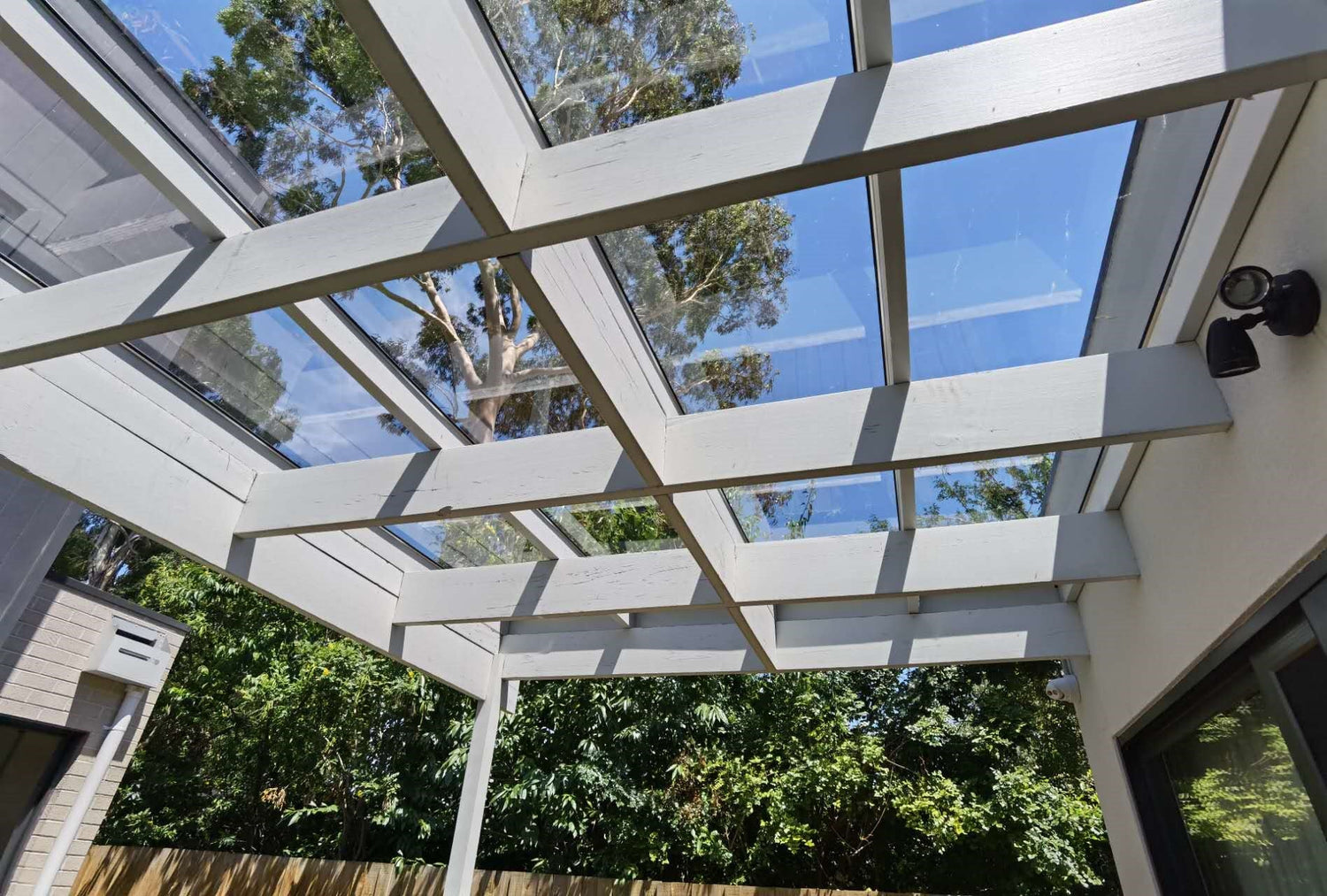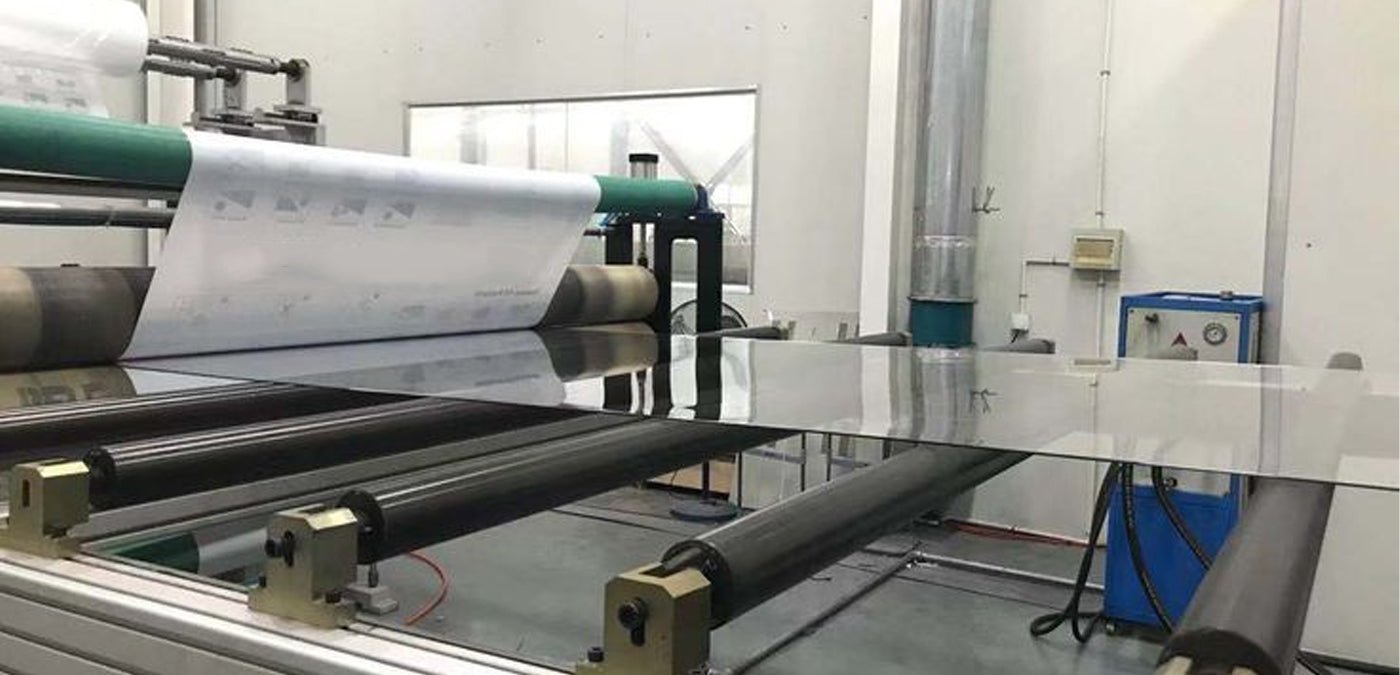Why Polycarbonate roofing is one of the best Alternatives for glass roof pergola
Same as you, we also like glass roofs when we build a veranda or cover a pergola. The clear roof you can see the blue sky, and enjoy outdoor living at any kind of weather condition. Then, what stops you from building a glass roof pergola?

- Glass breaks. Polycarbonate sheet is “unbreakable”
 Everybody knows that glass will break, not only break from any other impact but also toughed glass or tempered glass has 1% Spontaneous glass breakage, which may spontaneously break without any apparent reason. As an alternative for pergola roofs, polycarbonate roofing sheets perfectly avoid this, polycarbonate sheeting 250 times stronger than normal glass, and its hails proof. Polycarbonate sheets are being used as an excellent alternative to glass and fibreglass by designers for skylights, verandas, patios, pergolas, alfresco, and commercial or residential.
Everybody knows that glass will break, not only break from any other impact but also toughed glass or tempered glass has 1% Spontaneous glass breakage, which may spontaneously break without any apparent reason. As an alternative for pergola roofs, polycarbonate roofing sheets perfectly avoid this, polycarbonate sheeting 250 times stronger than normal glass, and its hails proof. Polycarbonate sheets are being used as an excellent alternative to glass and fibreglass by designers for skylights, verandas, patios, pergolas, alfresco, and commercial or residential.
Polycarbonate sheet is much safer than glass as a roofing material.
- Glass is much heavier than polycarbonate sheeting
Same thickness glass weight twice as polycarbonate sheet, 6mm solid polycarbonate sheet weighs 7.2kg/ m2, and 7.5mm laminated glass weighs 15kg/m2. The use of polycarbonate glazing can therefore offer a safer long-term solution for the building. Meanwhile, you need stronger frame to support glass glazing than polycarbonate glazing. It will increase your budget somehow.

- When you want to make a curved roof pergola or skylight
Of course, you can also bend glass by metal mold, but it will be much more expensive, and not very easy to handle. But you can easily build an artistic curved roof pergola or skylight by polycarbonate roofing sheets. The curved roof of arched Pergolas is particularly stunning, elegant and modern. The arched roof provides higher ceiling for your walkways, also much easier for drainage and cleaning.

Curved Roof Advantages,
- More Roof Space Curved roofs naturally give you more space than flat roofs pergola as the arch roof extends above the dimension of the flat surface.
- Natural Drainage: The curvature of the roof facilitates natural drainage of rainwater, snow, and debris. This can help prevent water pooling and minimise the risk of leaks or water damage, especially in Melbourne regions with heavy rainfall
- Architectural Appeal: Curved roofs provide a unique and visually striking appearance compared to traditional flat pergola or pitched roofs. They add a sense of elegance and modernity to a building's design, enhancing its overall aesthetic appeal.
- Natural Light and Ventilation: The curvature of the roof can be designed to incorporate larger windows or skylights, allowing for increased natural light and ventilation within the building. This can enhance indoor comfort, reduce reliance on artificial lighting, and improve energy efficiency.
- Acoustic Benefits: Curved roofs can help to diffuse sound waves more effectively compared to flat surfaces, resulting in improved acoustics within the building. This can be particularly advantageous in spaces such as auditoriums, concert halls, or recording studios.
4, Polycarbonate sheet is more cost friendly than glass.
Polycarbonate is generally more cost-friendly compared to glass. Polycarbonate sheets are lightweight and less expensive to produce, transport, and install than glass panels.
Additionally, the durability and impact resistance of polycarbonate contribute to lower maintenance and replacement costs over time. While glass may have a higher initial cost, polycarbonate offers a cost-effective alternative without compromising on transparency, making it a popular choice for various applications, including roofing and construction.

As a Pergola roofing material, polycarbonate roofing sheets has the following benefits:
- Weight - Polycarbonate is lighter than glass.
- Versatility - Polycarbonate sheeting is flexible and adaptable, you can bendi it or thermoform it.
- Impact resistance, 250 times stronger than glass
- Polycarbonate retains its colour, transparency, and shape for more than 10 years.
- Light transmission - Polycarbonate sheet can transfer far lighter than fiberglass.It also allows you to customize its shape, colours, and light transmission percentage.
Why Do we need daylighting?
When it comes to natural light, Polycarbonate sheets are an excellent roofing alternative since they provide the best of both worlds. They are available in a variety of hues and shades, and allow about the same amount of natural light into a structure as glass and far more than fibreglass.

More and more people are realizing that there is no reason to sacrifice natural light in favour of durability and safety. With polycarbonate roofing sheets, you may now sit beneath a pergola, gazebo, in a school, retail center, or any other facility and enjoy all of the natural light while being protected from the weather and benefiting from low long-term maintenance.
The advantages of daylighting
Most people take natural light for granted, but it is an extremely valuable resource, and it is free!

According to a 2014 study conducted by Northwestern Medicine and the University of Illinois, office workers who were exposed to more natural light in the workplace had longer sleep duration, better sleep quality, more physical activity, and a higher quality of life than office workers who were exposed to less natural light.
"There is growing evidence that exposure to light during the day, particularly in the morning, is advantageous to your health through its effects on mood, alertness, and metabolism," Phyllis Zee, M.D., a Northwestern Medicine Neurologist and Sleep Specialist, explains.
Sunlight stimulates the production of serotonin in our brains and provides us with Vitamin D. This new architectural method incorporates natural light into structures for these reasons, as well as to help them blend in with their surroundings. Furthermore, architects and builders can contribute to sustainability and achieve energy-saving standards by introducing natural light into structures and buildings (while still preserving insulation when necessary).

Controlling the passage of heat and light
It is critical to consider heat and light transmission when adding natural light into your structure. Naturally, as more light passes through a fully transparent roof, the temperature rises beneath it. According to science, this heat is caused by infrared radiation from the sun that accumulates beneath the roof.

As a pergola roofing material supplier, Excelite Plastic has been supplying pergola roofing sheets and doing Pergola installation in Melbourne for more than 5 years. We service Rowville, Glen Waverley, Mulgrave, Mount Waverley, Kew, Brighton and so many suburbs. We also do pergola renovation, old pergola roofing replacement etc. Talk to our professional team now.




1 comment
Michael
Hi
We have a light well in our home (converted warehouse) from level 1 up to level 2 which has had a polycarbonate type ribbed roof sheet installed into a timber frame structure.
I want to explore the option(s) to replace with flat type clear sheeting, as well as ‘clean’ up the current frame structure
Thanks
Michael
Hi
We have a light well in our home (converted warehouse) from level 1 up to level 2 which has had a polycarbonate type ribbed roof sheet installed into a timber frame structure.
I want to explore the option(s) to replace with flat type clear sheeting, as well as ‘clean’ up the current frame structure
Thanks
Michael